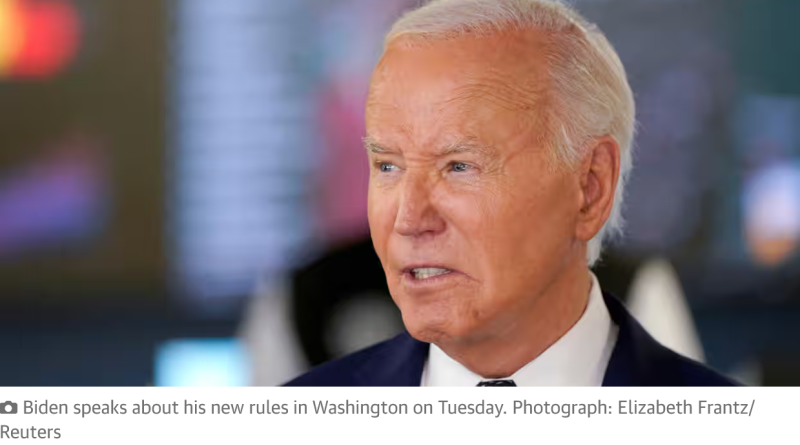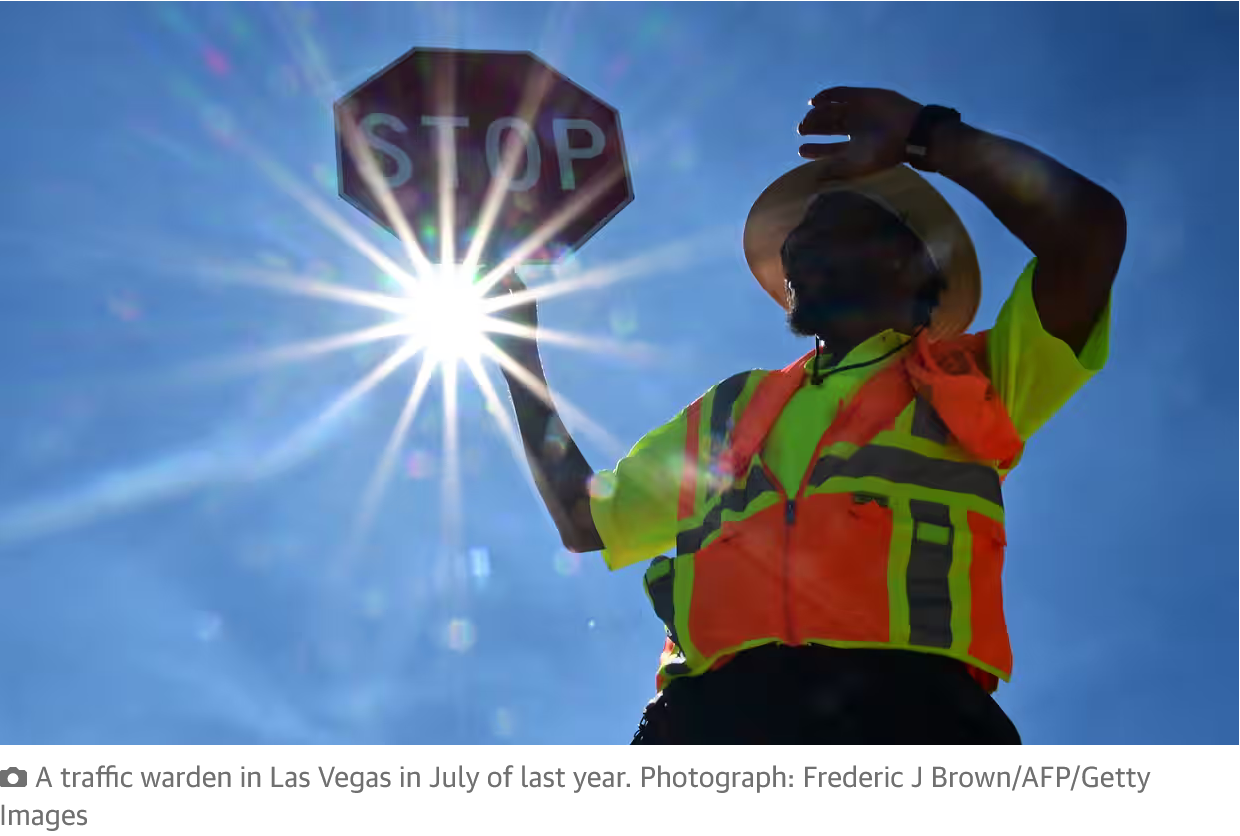Biden attacks Republican climate deniers as he unveils extreme-heat rules

President Biden on Tuesday trumpeted new rules from his administration that aim to protect Americans from extreme heat.
“Extreme heat is the No 1 weather-related killer in the United States,” he said at the Washington DC Emergency Operations Center. “More people die from extreme heat than floods, hurricanes and tornadoes combined.”
The speech came hours after the White House unveiled a long-awaited proposal to establish the nation’s first-ever federal workplace standard for extreme heat. If finalized, the rule “will substantially reduce heat injuries, illnesses and deaths for over 36m workers … construction workers, postal workers, manufacturing workers and so much more”, Biden said.
Labor and climate activists celebrated the administration’s new heat stress rule proposal, but finalizing it will be an uphill battle. It faces potential legal challenges from trade groups, and if Trump wins the November election, his administration could also refuse to greenlight the measure.
The White House also announced $1bn in grants for over 650 climate resilience projects across the country on Tuesday. Washington DC will receive over $3.5bn for infrastructure upgrades, said Muriel Bowser, the mayor, in her opening remarks.
Announced on Tuesday amid temperature warnings across the country, the rule would require employers to establish heat safety coordinators, undergo extreme heat safety training, create and regularly update emergency heat response plans, and provide workers with shade and water.
It would also require a heat acclimatization process for new employees to gradually increase their exposure to high temperatures.
The proposed rule includes specific safeguards for when the heat index in a workplace breaches 80F (27C), including increased access to water and temperature-controlled break rooms. At a 90F (32C) heat index, the standard would trigger additional protections, including paid 15-minute breaks every two hours, mandated observation of employees and hazard alerts for all workers.
Employers who fail to meet the standard could be subject to fines. Under the Occupational Safety and Health Administration’s general-duty clause, workplaces with dangerous levels of heat stress can be subject to penalties of roughly $16,000; the rule would substantially increase that amount, administration officials said.
In addition, the Environmental Protection Agency has released a new report showing the continued impacts of the climate crisis on people and ecosystems, while the Federal Emergency Management Agency will in the coming days finalize a rule to factor the impacts of flooding into all federally funded construction projects. And later this summer, the White House will also convene the first-ever White House summit on extreme heat, Biden said.
In Washington, the president railed against Republicans who “deny that climate change even exists”. Not a single congressional Republican voted for the Inflation Reduction Act, he noted, adding that many are now trying to repeal its green provisions. Donald Trump and “Maga Republicans in Congress” are working to “undo” the administration’s climate progress.
“I, quite frankly, think it’s not only outrageous, it’s really stupid,” he said. “When disaster strikes, there are no red states or blue states.”

Advocates and policymakers celebrated the move. “For decades, workers have been organizing for federal protections from the extreme heat. Despite opposition from big corporations, these working families are finally winning the protections they deserve,” said Representative Greg Casar of Texas, who last year went on an all-day thirst strike calling for heat protections.
Juley Fulcher, worker health and safety advocate with Public Citizen, said the plan was a “monumental victory for those who toil in the summer heat”.
“If enacted, the simple measures to protect workers – water breaks, a cool spot to recover and rest – will provide key protection from illness, injury and death.”
Extreme heat is the deadliest form of extreme weather, killing hundreds of Americans each year. The threat is increasing amid the climate crisis.
The Occupational Safety and Health Administration (Osha) projects that the rule would affect 36 million workers such as delivery people and mail carriers, construction workers and agricultural laborers, substantially reducing heat injuries, illnesses and deaths.
Dozens of workers die from heat exposure in the workplace every year. Federal data shows that the US saw 436 such deaths between 2011 and 2021 – a count that experts widely regard as conservative.
After years of pressure from climate and labor advocates, Osha began the years-long process of creating the federal heat rules in 2021. Last month, the agency submitted a proposal to the Office of Management and Budget for review. The speedy approval was possible thanks to years of hard work to craft a robust rule, according to senior administration officials.
The new rule would apply to all 50 US states, including Texas and Florida, which have passed laws preventing municipalities from adopting workplace heat safety measures. The 22 states that maintain their own Osha-approved workplace rules would be required to pass regulations that meet or exceed the federal heat standard’s protections.
The finalized proposal is a landmark step, but the Biden administration faces a long road ahead to ensure workers are protected from extreme heat. If Donald Trump wins in November, his administration could torpedo the effort.
The rule is also likely to face legal challenges from businesses and lobbying groups that have staunchly opposed such a measure.
Biden, however, assured attendees that the efforts will succeed.
“We’re just getting started here, man,” he said. “I’m confident we’re going to get this done.”
Despite years of public pressure, the Biden administration has not, however, declared a climate emergency. Doing so would unlock a trove of unilateral emergency powers to help quell the climate crisis.
Experts agree that curbing the climate crisis will also require the US to swiftly phase out fossil-fuel production. No country has ever produced more oil and gas in a single year than the US did in 2023.





